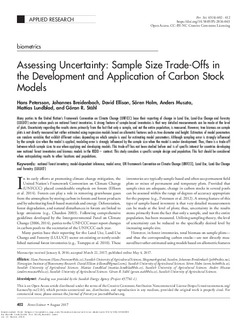| dc.contributor.author | Petersson, Hans | |
| dc.contributor.author | Breidenbach, Johannes | |
| dc.contributor.author | Ellison, David | |
| dc.contributor.author | Holm, Sören | |
| dc.contributor.author | Muszta, Anders | |
| dc.contributor.author | Lundblad, Mattias | |
| dc.contributor.author | Ståhl, Göran R. | |
| dc.date.accessioned | 2018-03-13T14:16:26Z | |
| dc.date.available | 2018-03-13T14:16:26Z | |
| dc.date.created | 2017-12-20T19:49:20Z | |
| dc.date.issued | 2017-08 | |
| dc.identifier.citation | Forest Science. 2017, 63 (4), 402-412. | nb_NO |
| dc.identifier.issn | 0015-749X | |
| dc.identifier.uri | http://hdl.handle.net/11250/2490344 | |
| dc.description.abstract | Many parties to the United Nation's Framework Convention on Climate Change (UNFCCC) base their reporting of change in Land Use, Land-Use Change and Forestry (LULUCF) sector carbon pools on national forest inventories. A strong feature of sample-based inventories is that very detailed measurements can be made at the level of plots. Uncertainty regarding the results stems primarily from the fact that only a sample, and not the entire population, is measured. However, tree biomass on sample plots is not directly measured but rather estimated using regression models based on allometric features such as tree diameter and height. Estimators of model parameters are random variables that exhibit different values depending on which sample is used for estimating model parameters. Although sampling error is strongly influenced by the sample size when the model is applied, modeling error is strongly influenced by the sample size when the model is under development. Thus, there is a trade-off between which sample sizes to use when applying and developing models. This trade-off has not been studied before and is of specific interest for countries developing new national forest inventories and biomass models in the REDD+ context. This study considers a specific sample design and population. This fact should be considered when extrapolating results to other locations and populations. | nb_NO |
| dc.language.iso | eng | nb_NO |
| dc.publisher | Oxford University Press | nb_NO |
| dc.rights | Navngivelse-Ikkekommersiell 4.0 Internasjonal | * |
| dc.rights.uri | http://creativecommons.org/licenses/by-nc/4.0/deed.no | * |
| dc.subject | national forest inventory | nb_NO |
| dc.subject | model-dependent inference | nb_NO |
| dc.subject | model error | nb_NO |
| dc.subject | UN Framework Convention on Climate Change (UNFCCC) | nb_NO |
| dc.subject | Land Use | nb_NO |
| dc.subject | Land-Use Change and Forestry (LULUCF) | nb_NO |
| dc.title | Assessing uncertainty: Sample size trade-offs in the development and application of carbon stock models | nb_NO |
| dc.type | Journal article | nb_NO |
| dc.type | Peer reviewed | nb_NO |
| dc.description.version | publishedVersion | nb_NO |
| dc.rights.holder | Copyright © 2017 Society of American Foresters. This is an Open Access article distributed under the terms of the Creative Commons Attribution Noncommercial License (https://creativecommons.org/licenses/by-nc/2.0/), which permits unrestricted use, distribution, and reproduction in any medium, provided the original work is properly cited. For commercial reuse, please contact the Journal of Forestry at journal@safnet.org. | nb_NO |
| dc.source.pagenumber | 402-412 | nb_NO |
| dc.source.volume | 63 | nb_NO |
| dc.source.journal | Forest Science | nb_NO |
| dc.source.issue | 4 | nb_NO |
| dc.identifier.doi | 10.5849/FS-2016-063 | |
| dc.identifier.cristin | 1530681 | |
| cristin.ispublished | true | |
| cristin.fulltext | original | |
| cristin.qualitycode | 1 | |

